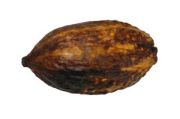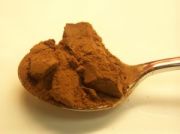
| branches > confectionery > cocoa (butter, powder) |
 download article
download articleCocoa manufacture
Drinking cocoa typically consists of cocoa powder, vanillin, cinnamon, salt, cassia and other powdered spices. Raw beans are received at the factory and subjected to a series of cleaning operations to remove extraneous matter such as fibre, stones, grit, metal, bean clusters and immature beans. The latter two materials may be used for cocoa butter manufacture.The beans are roasted; conditions vary depending on the equipment and the desired product, but are typically in the range of 100-140°C for 4-6 minutes. Whole beans or the separated “nibs” may be roasted. Winnowing is the separation of the bean outer shell from the edible “nibs” and typically consists of cracking the roasted bean between rollers, followed by air classification to remove the shell fragments. The nibs are ground to produce a cocoa liquor whose particle size is further reduced by grinding mills, which are water-cooled. The particle size is important for chocolate beverage manufacture but less important for chocolate since this requires some further refining.
The liquor or nibs from roasted or unroasted beans is likely to be subjected to a process known as “alkalisation” which increases the dispensability of cocoa powder in milk or water when used in beverages. It is also used to modify the colour of the cocoa. Only permitted acids, bases and emulsifiers may be used for this process. Cocoa powder is produced by the hydraulic pressing of cocoa liquor to express cocoa butter and to reduce the fat content of the press cake to the desired level. The expressed cocoa butter is used in chocolate manufacture. The press cake is pulverised to produce a cocoa powder. The final product is then packaged.
 back to top
back to top

 companies
companies


